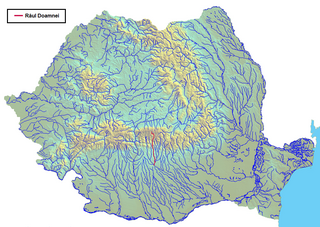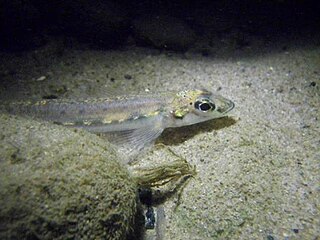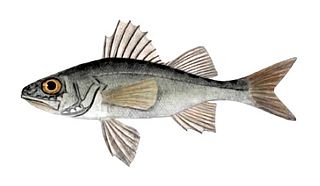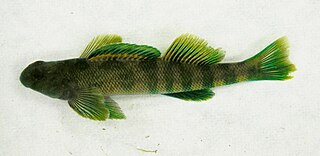
The Percidae are a family of ray-finned fish, part of the order Perciformes, which are found in fresh and brackish waters of the Northern Hemisphere. The majority are Nearctic, but there are also Palearctic species. The family contains more than 200 species in 11 genera. The perches, and their relatives are in this family; well-known species include the walleye, sauger, ruffe, and three species of perch. However, small fish known as darters are also a part of this family.

The zander, sander or pikeperch, is a species of ray-finned fish from the family Percidae, which also includes perch, ruffe and darter. It is found in freshwater and brackish habitats in western Eurasia. It is a popular game fish and has been introduced to a variety of localities outside its native range. It is the type species of the genus Sander.

Sander is a genus of predatory ray-finned fish in the family Percidae, which also includes the perches, ruffes, and darters. They are also known as "pike-perch" because of their resemblance to fish in the unrelated Esocidae (pike) family. They are the only genus in the monotypic tribe Luciopercini, which is one of two tribes in the subfamily Luciopercinae,

Râul Doamnei is a left tributary of the river Argeș in Romania. Its source is on the eastern slope of Moldoveanu Peak, the highest mountain peak in Romania. It discharges into the Argeș just north of Pitești. Its upper course, upstream from the confluence with the Zârna, is also called Valea Rea. Its length is 107 km (66 mi) and its basin size is 1,836 km2 (709 sq mi). It frequently dries up in summer, owing to the works upstream that have redirected part of its water supply toward a reservoir serving the hydroelectric plant on the Argeș.

Ammocrypta is a genus of freshwater ray-finned fish, commonly known as the sand darters, which is classified in the subfamily Etheostomatinae, part of the family Percidae which also includes the perches, ruffes and pikeperches. The species in the genus occur in eastern North America in Canada and the continental United States.

Crystallaria is a genus of freshwater ray-finned fish which is classified in the subfamily Etheostomatinae, commonly known as the darters, part of the family Percidae which also includes the perches, ruffes and pikeperches. They are found in the Mississippi River basin from Ohio to Minnesota and in southern Mississippi, northern Louisiana, and southeastern Oklahoma, and on the Gulf Slope of Escambia, Mobile Bay, and the Pearl River drainages. They have now been extirpated from Ohio, Kentucky, Indiana, and Illinois.

Gymnocephalus is a genus of ray-finned fishes from the family Percidae, which includes the perches, pike-perches and darters. They are from the Western Palearctic area, although one species, Gymnocephalus cernua has been accidentally introduced to the Great Lakes region where it is regarded as an invasive species. They have the common name "ruffe" and resemble the true perches in the genus Perca, but are usually smaller and have a different pattern.

Common percarina is a species of fish in the family Percidae. It is found in northwestern Black Sea basin in estuaries and coastal lakes, and in the lower reaches of the rivers that drain into that part of the Black Sea. It is a carnivorous species.

Percarina is a genus of ray-finned fish in the family Percidae found in eastern Europe. The genus is the only taxon in the monotypic subfamily Percarininae, which is characterised by having the first dorsal fin, having 9-11 spines and being widely separated from the second dorsal fin. They are thought to be closely related both to the perches of the genus Perca and to the ruffes of the genus Gymnocephalus.

The Volga pikeperch, or Volga zander, is a species of fish in the perch family Percidae. It is found in Austria, Azerbaijan, Bosnia and Herzegovina, Bulgaria, Croatia, Hungary, Moldova, Romania, Russia, Serbia, Slovakia, and Ukraine.

Zingel balcanicus, the Vardar streber is a species of freshwater ray-finned fish in the family Percidae, the perches, ruffes, pikeperches and the darters. This species is endemic to the Vardar or Axios River in North Macedonia and its distribution may extend to the lower reaches of the river in Greece. Its biology is little known but other species in the genus Zingel require turbulent flows.

Zingel is a genus of fish in the family Percidae. They are long and slender, reaching 12 to 48 cm in length. They are found in rivers and streams in Europe. They feed mainly on aquatic invertebrates such as crustaceans and insect larvae, and also eat small fish. While they were all classed as endangered or vulnerable in the past, environmental improvements have allowed some to be reclassified to least concern.

The diamond darter is a species of freshwater ray-finned fish, a darter from the subfamily Etheostomatinae, part of the family Percidae, which also contains the perches, ruffes and pikeperches. It is named for the sparkling light it reflects during nighttime collections. The diamond darter was first described in 2008 and is only the second known member of its genus, which also includes the crystal darter, C. asprella. On July 26, 2013, the United States Fish and Wildlife Service formally designated the diamond darter as an endangered species under the Endangered Species Act of 1973.
The emerald darter, is a species of freshwater ray-finned fish, a darter from the subfamily Etheostomatinae, part of the family Percidae, which also contains the perches, ruffes and pikeperches. It is found only in northern and eastern Kentucky and northeastern Tennessee.

The buffalo darter is a species of freshwater ray-finned fish, a darter from the subfamily Etheostomatinae, part of the family Percidae, which also contains the perches, ruffes and pikeperches. It is found in the tributaries of the lower Duck and lower Tennessee Rivers. It is distinguished from other darter species by the presence of eight anal rays, as well breeding males having a unique hump behind the head reminiscent of a buffalo.

The Cherokee darter is a rare species of freshwater ray-finned fish, a darter from the subfamily Etheostomatinae, part of the family Percidae, which also contains the perches, ruffes and pikeperches. It is endemic to Georgia in the United States, where it is limited to the Etowah River system. It inhabits creeks with rocky bottoms and little silt, typically occurring just above and below riffles. It is a whitish or yellowish fish with green and black spots on the flanks and eight dark saddle-like bars dorsally. It has a small range and its habitat is being degraded and fragmented, and the International Union for Conservation of Nature has assessed its conservation status as being endangered.

Zingel zingel, the zingel, is a species of freshwater ray-finned fish in the family Percidae. It is found in fast-flowing streams in southeastern Europe. It is the type species of the genus Zingel.

The Luciopercinae is a subfamily of ray-finned fish, classified within the family Percidae, the subfamily includes the pike-perches and zingels. The pike-perches of the genus Sander have an Holarctic distribution while the zingels of the tribe Romanichthyini are found in Europe. They are largely freshwater species but some can be found in brackish water.

Romanichthyini is a tribe of freshwater ray-finned fish which is one of two tribes in the subfamily Luciopercinae, which in turn is classified under the family Percidae, the family also includes the perches, pikeperches, ruffes and darters.

Etheosomatidae is a species-rich subfamily of freshwater ray-finned fish, the members of which are commonly known as the darters. The subfamily is part of the family Percidae which also includes the perches, ruffes and pikeperches. The family is endemic to North America. It consists of 3-5 different genera and well over 200 species.



















